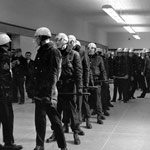| Juanita Moore, Herb Gaede, Robert Hayes, Gladys Coleman, Henry Brown, Geoff McCreary, Sandy McCreary, telephone wiring technician Jim Barr, Franklin Utech, Oshkosh police officer Bill Gonyo, Noreen Debnam, Vada Harris, and John Schuh relate their memories of November 21. - 7.9mb mp3 |
Please click a thumbnail for more detail.



Photos of November 21, 1968 takeover of the executive offices at WSU-O. Henry Brown gives the black power sign.
Photo of Henry Brown by The Paper of Central Wisconsin and images above are courtesy of the UW Oshkosh Archives.


Photo by Harvey Roesler courtesy of The Advanced Titan.

Photo by The Paper of Central Wisconsin.

Photo courtesy of The Advanced Titan.
Many of the ninety black students who assembled on Algoma Boulevard at 8:30 on the morning of November 21 were tense, nervous and angry. As a group, the students had resolved to hand President Guiles a list of demands—a more forceful, and determined list than what the group had submitted in October. They hoped he would sign the list and thereby give his consent to an expedited effort to resolve several outstanding issues. Failing that, some of the students hoped to obtain at least some acknowledgement of their concerns. But no one who ascended the stairs of Dempsey Hall on the way to the executive offices knew how the president or anyone else would act under pressure.
When the students finally appeared in the executive offices, President Guiles, sitting at his desk, looked up and, startled, asked: “Do you have an appointment?” Forty students silently crowded into his office and presented the demands. Guiles steadfastly refused claiming that he did not possess the authority alone to take action. What happened next has been disputed for forty years. According to Roger Guiles and a second administrator present at the scene, a directive to “do your thing” issued by one of the students signaled a brief but intense bout of vandalism, with typewriters thrown to the ground, desks overturned, ink spilled onto carpets, windows broken, and administrative files and records strewn about. Disputing the notion of a premeditated plan of attack, many students have claimed that the destruction erupted spontaneously, spurred on by the anger and frustration that had been building within them for weeks and now suddenly triggered by the countenance of the obstinate white authority figure who was before them.
Absent direct evidence and instead dependent on clashing eyewitness accounts, on disputed testimony taken at subsequent disciplinary hearings and the imperfect memories recorded in years since, what transpired in Dempsey Hall on the morning of November 21, 1968—“Black Thursday,” as the student newspaper The Advance Titan designated it several weeks later—will always be somewhat shrouded in mystery. It seems clear, however, that students’ culpability varied widely, that a good number of students were only witnesses and not participants in the destruction.
With a renewed sense of urgency, President Guiles explained to the black students that he could authorize nothing until he received a report from the committee of faculty and administrators who were coincidentally meeting that same morning to discuss the demands the students had submitted earlier. The students vowed to sit and wait in the Executive Offices until the Committee issued its report and a timetable for subsequent action was reached with President Guiles. “I can give up a few hours of my life for my future,” one student resigned as she prepared to wait. While a few plainclothes Oshkosh police, photographers and angry white students assembled just outside of the executive offices, students sat scattered within, some passing around books and engaging in conversation, others singing freedom songs. When one of the students saw a throng of police in riot gear approaching, the atmosphere grew suddenly tense. Following Oshkosh Police Captain Robert Kliforth’s order to vacate the offices, the students hastily weighed their options. Fortunately, those who pleaded with their fellow students to “go to jail peacefully” prevailed. The students were escorted outside of Dempsey Hall along a phalanx of helmeted police—obtained through the cooperation of nine cities throughout the region—and then herded into rented Hertz trucks idling outside.
Taken to the Winnebago County courthouse shortly before noon, the students were formally charged with unlawful assembly and disorderly conduct, arraigned, and then distributed to prisons as far away as Green Bay. As nightfall approached, feelings of fear, anger and confusion hung over Oshkosh and its Wisconsin State campus. Alerted to the events of the morning, Father James Groppi traveled swiftly to Oshkosh. He was met by NAACP Commandos from Milwaukee and members of Madison’s Black People’s Alliance, all of whom had converged in WSU-O’s Reeve Memorial Union along with leaders of white student groups who were sympathetic to the black students’ plight. When plans to stage a sit-in there were foiled by police, nearly a thousand students and activists marched down Algoma Boulevard toward the Winnebago County Courthouse. As protestors later surrounded the president’s darkened home, Roger Guiles huddled with his advisors and made two decisions: he would close the university for Thanksgiving break five days early in an effort to ease tensions and prevent the outbreak of violence and, more importantly, he would initiate procedures to have the students who occupied his office permanently expelled from the university.
